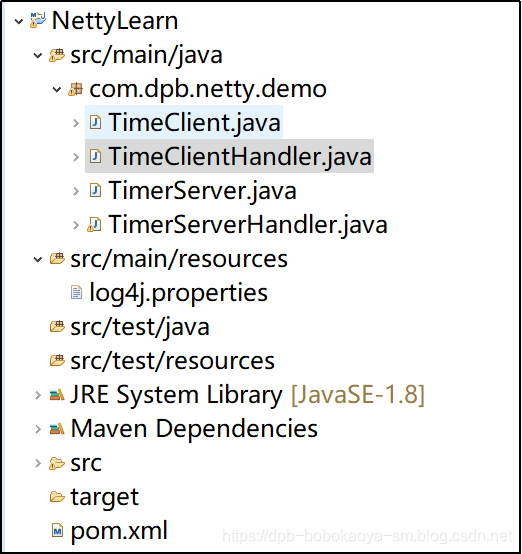Netty之入门案例
【摘要】
前面给大家介绍了NIO,我们会发现用NIO实现异步非阻塞的网络通信代码量非常大,而且并不是很好理解,在实际的开发中一般我们也都是会实现基于NIO的框架来操作的,比如Netty,这样开发效率有高而且Bu...
前面给大家介绍了NIO,我们会发现用NIO实现异步非阻塞的网络通信代码量非常大,而且并不是很好理解,在实际的开发中一般我们也都是会实现基于NIO的框架来操作的,比如Netty,这样开发效率有高而且Bug也少。
Netty入门案例
环境准备
你可以去官网下载对应的jar包依赖,然后创建普通的java项目即可,也可以跟着我通过创建maven项目来实现,如下是会用到的依赖
<dependencies>
<dependency>
<groupId>io.netty</groupId>
<artifactId>netty-all</artifactId>
<version>5.0.0.Alpha2</version>
</dependency>
<dependency>
<groupId>org.slf4j</groupId>
<artifactId>slf4j-log4j12</artifactId>
<version>1.7.25</version>
</dependency>
</dependencies>
- 1
- 2
- 3
- 4
- 5
- 6
- 7
- 8
- 9
- 10
- 11
- 12
- 13
log4j.properties属性文件
log4j.rootCategory=info, stdout , R
log4j.appender.stdout=org.apache.log4j.ConsoleAppender
log4j.appender.stdout.layout=org.apache.log4j.PatternLayout
log4j.appender.stdout.layout.ConversionPattern=[QC] %p [%t] %C.%M(%L) | %m%n
log4j.appender.R=org.apache.log4j.DailyRollingFileAppender
log4j.appender.R.File=C:\\Tomcat 5.5\\logs\\qc.log
log4j.appender.R.layout=org.apache.log4j.PatternLayout
log4j.appender.R.layout.ConversionPattern=%d-[TS] %p %t %c - %m%n
- 1
- 2
- 3
- 4
- 5
- 6
- 7
- 8
- 9
- 10
服务端
TimerServer
package com.dpb.netty.demo;
import io.netty.bootstrap.ServerBootstrap;
import io.netty.channel.ChannelFuture;
import io.netty.channel.ChannelInitializer;
import io.netty.channel.ChannelOption;
import io.netty.channel.nio.NioEventLoopGroup;
import io.netty.channel.socket.SocketChannel;
import io.netty.channel.socket.nio.NioServerSocketChannel;
public class TimerServer {
public void bind(int port) throws Exception{
// 配置服务端的NIO线程组
// 服务端接受客户端的连接
NioEventLoopGroup bossGroup = new NioEventLoopGroup();
// 进行SocketChannel的网络读写
NioEventLoopGroup workerGroup = new NioEventLoopGroup();
try {
// 用于启动NIO服务端的辅助启动类,目的是降低服务端的开发复杂度
ServerBootstrap b = new ServerBootstrap();
b.group(bossGroup,workerGroup)
// 设置Channel
.channel(NioServerSocketChannel.class)
// 设置TCP参数
.option(ChannelOption.SO_BACKLOG, 1024)
// 绑定I/O事件的处理类ChildChannelHandler
.childHandler(new ChildChannelHandler());
// 绑定端口,同步等待成功
ChannelFuture f = b.bind(port).sync();
// 等待服务端监听端口关闭
f.channel().closeFuture().sync();
} finally {
// 优雅退出,释放线程池资源
bossGroup.shutdownGracefully();
workerGroup.shutdownGracefully();
}
}
private class ChildChannelHandler extends ChannelInitializer<SocketChannel>{
@Override
protected void initChannel(SocketChannel arg0) throws Exception {
arg0.pipeline().addLast(new TimerServerHandler());
}
}
public static void main(String[] args) throws Exception {
int port = 8080;
new TimerServer().bind(port);
}
}
- 1
- 2
- 3
- 4
- 5
- 6
- 7
- 8
- 9
- 10
- 11
- 12
- 13
- 14
- 15
- 16
- 17
- 18
- 19
- 20
- 21
- 22
- 23
- 24
- 25
- 26
- 27
- 28
- 29
- 30
- 31
- 32
- 33
- 34
- 35
- 36
- 37
- 38
- 39
- 40
- 41
- 42
- 43
- 44
- 45
- 46
- 47
- 48
- 49
- 50
- 51
- 52
- 53
- 54
- 55
- 56
- 57
- 58
TimerServerHandler
package com.dpb.netty.demo;
import java.nio.ByteBuffer;
import io.netty.buffer.ByteBuf;
import io.netty.buffer.Unpooled;
import io.netty.channel.ChannelHandlerAdapter;
import io.netty.channel.ChannelHandlerContext;
/**
* 用于对网络事件进行读写操作
* @author 波波烤鸭
* @email dengpbs@163.com
*
*/
public class TimerServerHandler extends ChannelHandlerAdapter{
@Override
public void channelRead(ChannelHandlerContext ctx, Object msg) throws Exception {
// ByteBuf 类似于NIO中的java.nio.ByteBuffer对象,
ByteBuf buf = (ByteBuf) msg;
byte[] req = new byte[buf.readableBytes()];
buf.readBytes(req);
String body = new String(req,"utf-8");
System.out.println("The time server receive order : "+body);
String currentTime = "Query time order".equalsIgnoreCase(body)?new java.util.Date(System.currentTimeMillis()).toString():"BAD ORDER";
ByteBuf resp = Unpooled.copiedBuffer(currentTime.getBytes());
ctx.write(resp);
}
@Override
public void channelReadComplete(ChannelHandlerContext ctx) throws Exception {
// TODO Auto-generated method stub
ctx.flush();
}
@Override
public void exceptionCaught(ChannelHandlerContext ctx, Throwable cause) throws Exception {
// TODO Auto-generated method stub
ctx.close();
}
}
- 1
- 2
- 3
- 4
- 5
- 6
- 7
- 8
- 9
- 10
- 11
- 12
- 13
- 14
- 15
- 16
- 17
- 18
- 19
- 20
- 21
- 22
- 23
- 24
- 25
- 26
- 27
- 28
- 29
- 30
- 31
- 32
- 33
- 34
- 35
- 36
- 37
- 38
- 39
- 40
- 41
客户端
TimeClient
package com.dpb.netty.demo;
import io.netty.bootstrap.Bootstrap;
import io.netty.channel.ChannelFuture;
import io.netty.channel.ChannelInitializer;
import io.netty.channel.ChannelOption;
import io.netty.channel.EventLoopGroup;
import io.netty.channel.nio.NioEventLoopGroup;
import io.netty.channel.socket.SocketChannel;
import io.netty.channel.socket.nio.NioSocketChannel;
public class TimeClient {
public static void main(String[] args) throws Exception {
int port = 8080;
new TimeClient().connect(port, "127.0.0.1");
}
public void connect(int port,String host)throws Exception{
// 配置客户端NIO线程组
EventLoopGroup group = new NioEventLoopGroup();
try{
Bootstrap b = new Bootstrap();
b.group(group).channel(NioSocketChannel.class)
.option(ChannelOption.TCP_NODELAY, true)
.handler(new ChannelInitializer<SocketChannel>() {
@Override
protected void initChannel(SocketChannel arg0) throws Exception {
arg0.pipeline().addLast(new TimeClientHandler());
}
});
// 发起异步连接操作
ChannelFuture f = b.connect(host,port).sync();
// 等待客户端链路关闭
f.channel().closeFuture().sync();
}catch(Exception e){
e.printStackTrace();
}finally{
// 优雅退出,释放NIO线程组
group.shutdownGracefully();
}
}
}
- 1
- 2
- 3
- 4
- 5
- 6
- 7
- 8
- 9
- 10
- 11
- 12
- 13
- 14
- 15
- 16
- 17
- 18
- 19
- 20
- 21
- 22
- 23
- 24
- 25
- 26
- 27
- 28
- 29
- 30
- 31
- 32
- 33
- 34
- 35
- 36
- 37
- 38
- 39
- 40
- 41
- 42
- 43
- 44
- 45
TimeClientHandler
package com.dpb.netty.demo;
import java.util.logging.Logger;
import io.netty.buffer.ByteBuf;
import io.netty.buffer.Unpooled;
import io.netty.channel.ChannelHandlerAdapter;
import io.netty.channel.ChannelHandlerContext;
public class TimeClientHandler extends ChannelHandlerAdapter{
private static final Logger logger = Logger.getLogger(TimeClientHandler.class.getName());
private final ByteBuf firstMessage;
public TimeClientHandler(){
byte[] req = "Query time order".getBytes();
firstMessage = Unpooled.buffer(req.length);
firstMessage.writeBytes(req);
}
@Override
public void channelActive(ChannelHandlerContext ctx) throws Exception {
ctx.writeAndFlush(firstMessage);
}
@Override
public void channelRead(ChannelHandlerContext ctx, Object msg) throws Exception {
ByteBuf buf = (ByteBuf) msg;
byte[] req = new byte[buf.readableBytes()];
buf.readBytes(req);
String body = new String(req,"UTF-8");
System.out.println("Now is :"+body);
}
@Override
public void exceptionCaught(ChannelHandlerContext ctx, Throwable cause) throws Exception {
// TODO Auto-generated method stub
logger.warning("Unexpected exception from downstream:"+cause.getMessage());
ctx.close();
}
}
- 1
- 2
- 3
- 4
- 5
- 6
- 7
- 8
- 9
- 10
- 11
- 12
- 13
- 14
- 15
- 16
- 17
- 18
- 19
- 20
- 21
- 22
- 23
- 24
- 25
- 26
- 27
- 28
- 29
- 30
- 31
- 32
- 33
- 34
- 35
- 36
- 37
- 38
- 39
- 40
- 41
- 42

测试
先启动服务器,再启动客户端,输出如下:
服务端
The time server receive order : Query time order
- 1
客户端
Now is :Thu Apr 11 22:22:58 CST 2019
- 1
总结
通过案例使用Netty实现了客户端和服务器的通信,可以发现相比传统的NIO程序,Netty的代码更加简洁,开发难度更低,扩展性也更好,非常适合作为基础通信框架被用户集成和使用
文章来源: dpb-bobokaoya-sm.blog.csdn.net,作者:波波烤鸭,版权归原作者所有,如需转载,请联系作者。
原文链接:dpb-bobokaoya-sm.blog.csdn.net/article/details/89221748
【版权声明】本文为华为云社区用户转载文章,如果您发现本社区中有涉嫌抄袭的内容,欢迎发送邮件进行举报,并提供相关证据,一经查实,本社区将立刻删除涉嫌侵权内容,举报邮箱:
cloudbbs@huaweicloud.com
- 点赞
- 收藏
- 关注作者


评论(0)